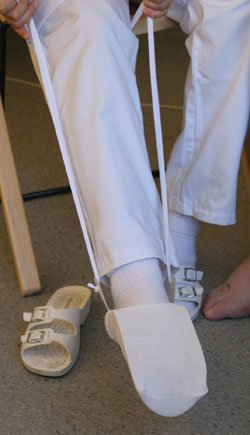No downsides seen in not restricting hip motion following hemiarthroplasty
Investigators concluded a direct lateral surgical approach without restricting postoperative activity nearly eliminated hip dislocations.
Surgeons who performed hemiarthroplasty for femoral neck fractures using a direct lateral approach, but did not restrict the patient’s activities, found no postoperative dislocations occurred in the group, according to findings of an ongoing study.
“We have a very interesting trend toward a better functional outcome in those without restrictions, but still I cannot say that it is the way it is going to end. But it looks very hopeful,” Cecilia Rogmark, MD, PhD, of Skane University Hospital, Malmo, Sweden, told Orthopaedics Today Europe.
Rogmark presented the findings at the SICOT XXV Triennial World Congress 2011 in Prague.
She said, “This study was actually a request from our physiotherapist and our occupational therapist […] the physical therapists are the ones who are going to train the patients and it is very difficult to do that with all these restrictions in mind.”
Trend presents challenges
|
|
Movement restrictions of any kind can be costly to hospitals and time consuming for physical and occupational therapists to implement, Rogmark said.
Routine treatment for patients with displaced femoral neck fractures at her institution consisted of hemiarthroplasty via the direct anterolateral approach with movement restrictions postoperatively. However, once the therapists noticed that the dislocation rate after hip fractures at Skane University Hospital averaged 0.6% in 2008 vs. 2% to 14% elsewhere — and realized that such restrictions were not evidence-based — they questioned what they were doing differently and why they were ordering movement restrictions at all.
Therefore, Rogmark’s study sought to determine if such restrictions were actually beneficial. The literature on this topic, including postoperative restrictions after total hip arthroplasty (THA), is scarce, according to Rogmark.
Rogmark and colleagues conducted a pseudo-randomized study of patients who underwent hemiarthroplasty via the direct lateral approach for displaced femoral neck fractures dividing them into two cohorts: 32 patients were given no restrictions or aids, and 40 control patients were required to use various aids and restrict their hip flexion 90° maximum. Control patients could not cross their legs and those with dementia wore knee braces to restrict them from doing so.
|
Image: Rogmark C |
Investigators determined the patients’ health-related quality of life, need to use aids for activities of daily living pre-fracture and at 5 days, 6 weeks and 3 months postoperatively, and postoperative function at 5 days and 3 months. Based on the medical records, they quantified the dislocations and falls in each group.
Some patients dropped out of the study and those not available for the 3 month follow-up were excluded.
The surgical team used the direct lateral approach in all patients, a technique that Rogmark explained could, in itself, hinder dislocation and possibly prevent subsequent reoperations.
No dislocations
Rogmark and colleagues observed no dislocations in the group without restrictions and two dislocations in the motion-restricted control group.
“Even if they are free of restriction and they do not need any mandatory aids, we do not see any increase in dislocation,” Rogmark said. “The working time for the physical therapist is much less when they do not need to do all this standard talking, giving standard advice to patients. They can focus on doing a customized training for the patients. So it is less time consuming for the physiotherapist,” she noted.
Investigators plan to follow these patients up to 3.5 years, hoping to enroll 800 patients. As of November 2011, Rogmark had enrolled 200 patients in the study — 100 patients per group. Her team also plans to study THA dislocation rates due to their increasing incidence in Sweden.
“In several countries, it is regarded as quite exotic that we do total hip replacements in hip fracture patients because hemiarthroplasties are always considered to be the gold standard. But we have seen better clinical results in […] more healthy elderly [patients] with displaced femoral neck fractures,” Rogmark said. – by Renee Blisard
Reference:
- Rogmark C, Nilsson I, Dahlqvist L, et al. Is movement restrictions after hemiarthroplasty treatment of femoral neck fractures necessary? Paper #29881. Presented at the SICOT XXV Triennial World Congress 2011. Sept. 6-9. Prague.

- Cecilia Rogmark, MD, PhD, can be reached at the Department of Orthopaedic Surgery, Skane University Hospital, Lund University, 205 02 Malmo, Sweden; +46 040-33 10 00; email: cecilia.rogmark@skane.se.
- Disclosure: Rogmark has no relevant financial disclosures.












